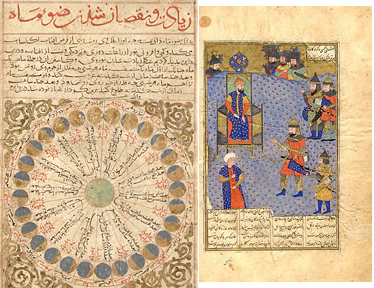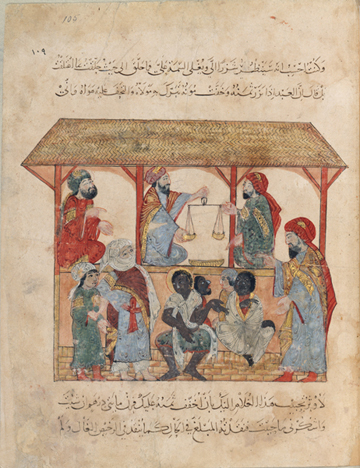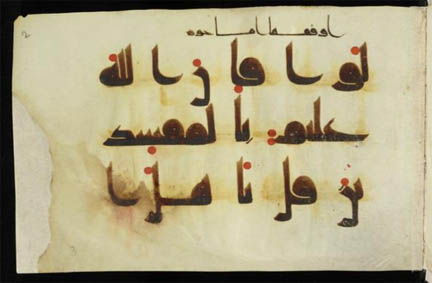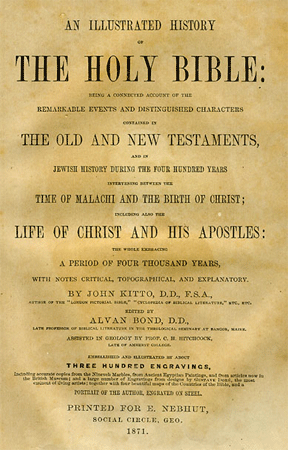
The aftermath of the protests in Sanaa, the capital of Yemen, left many walls filled with dueling graffiti. One Yemeni artist has taken to the streets, bringing neighborhoods together, to take back the walls through art. See the video here.

The aftermath of the protests in Sanaa, the capital of Yemen, left many walls filled with dueling graffiti. One Yemeni artist has taken to the streets, bringing neighborhoods together, to take back the walls through art. See the video here.

Cartoon by Khalil Bendib on Jadaliyya

So many scenes of tanks and blood-soaked Syrian bodies, although there seem to be few good Samaritans willing to stop and heal the wounds. But there is also art, the spirit of which bullets can never penetrate …

left, Illustration of the phases of the Moon (Or. 133, Golius collection) ;right, Firdawsi, Shahnama (15th century, Or. 494)
There are thousands of Middle Eastern manuscripts preserved in European libraries. One of the famous collections is that of Leiden University. Imagine if those were available online? It would be a dream come true for budding scholars and the old guard alike. A dream, indeed. Leiden University has joined with Brill to provide this collection online, but at a cost. The price posted is a mere (I mean only an emir can afford it) $25,900. I suspect it will take only a few sales to recoup the costs of onlining the manuscripts (and perhaps onlining the profits of both the Leiden libraries (a worthy cause) and Brill (a publisher that already charges so much that few can afford their books). Actually, it may be cheaper to matriculate at Leiden University, since university members have free access.
For those who are interested (either to lament or to have lots of money and little to do with it), here are the details:
Continue reading The Cost of Orientalism


Slave Market in Yemen, 1237
Al-Maqamat, folio 105. Author: al-QÄsim ibn AlÄ« al HarÄ«rÄ« al-BasrÄ«. Illuminator: Yahya ben Mahmud al-Wasiti. Bibliothèque nationale de France. 021, an enslaved Ethiopian, Najah, seized power in the city of Zabid. This image represents the slave market at Zabid—at the time the capital of Yemen—in 1237. The illustration is part of “Al-Maqamat†(Assemblies), a genre of rhymed prose narrative. Both the author and the illuminator of this work were born in Iraq.
The Schomburg Center for Research in Black Culture has posted online a very nice exhibition on the African diaspora in the Indian Ocean World with illustrations and scholarly text. Continue reading The African Diaspora in the Indian Ocean World

Can’t afford to go to Dubai? Then you can build you own paper version of the Dubai clock tower at home by clicking here.

The Cambridge Digital Library now has online access to some of their Islamic manuscripts. Details below, as described on the website:
Cambridge University Library’s collection of Islamic manuscripts dates from the origins of Arabic scholarship in Cambridge in the 1630s when the University founded a Professorship in Arabic and William Bedwell donated a Qur’an to the Library. Since that time the collection has grown in size and diversity to over 5,000 works, including the collections of Thomas Erpenius, J.L.Burckhardt, E.H.Palmer and E.G. Browne. These manuscripts shed light on many aspects of the Islamic world, its beliefs and learning.
The collection was further enriched over the centuries through the activities of scholarly collectors and skilled librarians, adding more depth to the already impressive range of manuscripts. Yet this extraordinary collection has remained relatively unknown outside Cambridge. Now we hope to draw better attention to its treasures through cataloguing and digitisation. We have collaborated with the Bodleian at Oxford and other research libraries to provide an online catalogue of the collection. We will be offering a selection of digitised manuscripts through the Foundations project and will seek funding for further digitisation. Continue reading Islamic Manuscripts at Cambridge

As a child I spent many inquisitive hours leafing through the books in my grandmother’s parlor bookcase. One that especially attracted my attention was John Kitto’s An Illustrated History of the Holy Bible (Social Circle, Georgia: E. Nebhut, 1871). Rev. John Kitto, recognized on the title page as author of the London Pictorial Bible, the Cyclopedia of Biblical Literature, ETC, ETC, retells the entire history of the Old and New Testament, from creation to the destruction of Jerusalem. Kitto was born into poverty in 1804 in Plymouth, England and due to an unfortunate accident ate age thirteen became entirely deaf and was forced into the poor house at the age of fifteen. This is quite an inauspicious beginning for a waif who went on to be a respected theological scholar. Through the local humanitarian efforts of several men in Plymouth, Kitto became a lay missionary to Malta and then for three and a half years in Baghdad. “While residing in that city,†writes Alvan Bond in the preface to Kitto’s book, Cairo “was visited by the plague, the terrific ravages of which swept off more than one-half the inhabitants in two months. Amidst this fearful desolation he remained calm and active at his post.†Once back in England he married and produced a travel account and several pictorial histories of the Holy Land. In 1844 the University of Giessen conferred upon him the degree of D.D. His ill health forced him to seek help in the spas of Germany, where he died after a mere half century in 1854. Continue reading Tabsir Redux: With Kitto Illustrating Bible History